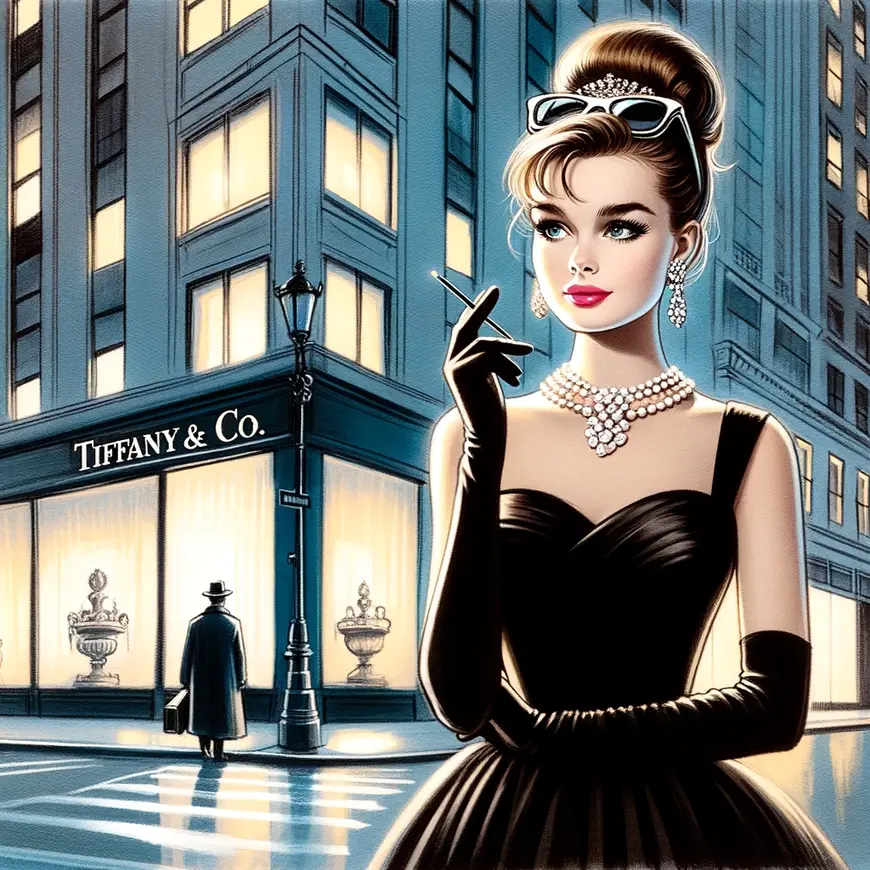“Breakfast at Tiffany’s” by Truman Capote: A Timeless Tale of Love, Loss, and Glamour
“Breakfast at Tiffany’s” by American Author Truman Capote is more than just a novella—it’s a cultural touchstone, a timeless tale that has captivated readers for generations. Published in 1958, this slim volume packs a punch, drawing readers into the glittering world of New York City’s social elite while simultaneously peeling back the layers of loneliness and longing that lie beneath the surface. As we journey through the pages of “Breakfast at Tiffany’s,” we are enveloped in a narrative that is as poignant as it is glamorous, as heartwarming as it is heartbreaking.
Unveiling the Charms of “Breakfast at Tiffany’s”
Holly Golightly: A Literary Icon: At the heart of “Breakfast at Tiffany’s” is the indomitable figure of Holly Golightly—a woman as enigmatic as she is alluring, as complex as she is captivating. From the moment she sashays onto the page, clad in her iconic little black dress and oversized sunglasses, Holly bewitches readers with her irreverent charm and irrepressible spirit. She is a symbol of independence and resilience, a woman determined to live life on her own terms, even as she grapples with the ghosts of her past and the uncertainties of her future.
The Narrator: Witness to Glamour and Grief: As our guide through the labyrinthine world of “Breakfast at Tiffany’s,” the unnamed narrator provides a window into Holly’s glamorous yet tumultuous life. A struggling writer drawn into Holly’s orbit, the narrator becomes both observer and confidant, privy to the intimate details of her triumphs and tribulations. Through his eyes, we gain insight into Holly’s innermost thoughts and desires, as well as the complexities of their unconventional friendship.
New York City: The Ultimate Backdrop: Set against the backdrop of 1950s New York City, “Breakfast at Tiffany’s” unfolds amidst the glittering lights of Broadway, the chic boutiques of Fifth Avenue, and the smoky jazz clubs of Greenwich Village. Capote’s vivid descriptions evoke the sights, sounds, and smells of the era, immersing readers in a world of sophistication and style, where glamour and grit collide in a kaleidoscope of contradictions.

The Charms and Contradictions of Holly Golightly
The Enigma of Holly Golightly: Holly Golightly is a character shrouded in mystery—a woman of contradictions whose layers are slowly peeled away as the narrative unfolds. On the surface, she is the epitome of glamour and sophistication, a socialite who flits from one party to the next with effortless grace. Yet beneath the veneer of glamour lies a woman haunted by her past, a lost soul searching for love and belonging in a world that often feels indifferent to her charms.
Glamour and Grit: Holly Golightly embodies the paradox of 1950s glamour—a world of champagne cocktails and couture gowns, juxtaposed against the harsh realities of loneliness and disillusionment. Capote deftly navigates this dichotomy, painting a portrait of a woman who is simultaneously captivating and vulnerable, glamorous yet deeply flawed. Through Holly’s eyes, we see the allure of wealth and status, as well as the emptiness that lurks beneath the surface.
The Pursuit of Freedom: At its core, “Breakfast at Tiffany’s” is a story about the pursuit of freedom—the quest for self-discovery and independence in a world that seeks to confine and define us. Holly Golightly is a woman who refuses to be bound by societal norms or expectations, forging her own path in a world that often seeks to silence her voice. Her quest for freedom becomes a universal metaphor for the human desire to break free from the constraints of convention and live life on our own terms.
Love and Loss in the City That Never Sleeps
Romance and Heartbreak: Central to the narrative of “Breakfast at Tiffany’s” is the theme of romance and heartbreak—the bittersweet dance of love and loss that defines Holly Golightly’s relationships. From her ill-fated affair with the wealthy playboy Rusty Trawler to her complicated bond with the narrator himself, Holly’s romantic entanglements are a testament to the complexities of the human heart. Capote deftly captures the highs and lows of love, infusing the narrative with a sense of longing and longing that resonates long after the final page is turned.
The Cat: A Symbol of Solitude and Connection: An iconic symbol in “Breakfast at Tiffany’s” is the nameless cat that accompanies Holly throughout her adventures. A creature of solitude and companionship, the cat becomes a silent witness to Holly’s triumphs and tribulations, serving as a metaphor for the human need for connection and companionship in a world that often feels cold and indifferent. Through the cat’s eyes, we see the vulnerability that lies beneath Holly’s glamorous facade, as well as the capacity for love and loyalty that defines their unconventional bond.
Loss and Longing: Amidst the glitz and glamour of 1950s New York City, “Breakfast at Tiffany’s” is ultimately a story about loss and longing—the ache of unfulfilled dreams, the pain of missed opportunities, and the yearning for connection in a world that often feels fragmented and disjointed. Capote’s prose is suffused with a sense of melancholy and nostalgia, as he captures the fleeting moments of beauty and joy that punctuate Holly Golightly’s turbulent journey.

Criticisms: Controversy and Interpretive Challenges
Depictions of Gender and Sexuality: Some critics have pointed to the problematic depictions of gender and sexuality in “Breakfast at Tiffany’s,” particularly in relation to Holly Golightly’s character. While she is celebrated as a symbol of independence and resilience, others argue that her portrayal perpetuates harmful stereotypes about women and reinforces traditional notions of femininity and masculinity.
Racial Stereotypes: Another point of contention in “Breakfast at Tiffany’s” is the depiction of racial minorities, particularly in the character of Mr. Yunioshi—a Japanese neighbor portrayed in a manner that is widely considered offensive and racially insensitive. Critics have criticized Capote’s use of racial stereotypes and caricatures, arguing that they detract from the novel’s otherwise nuanced portrayal of identity and belonging.
Famous Quotes from “Breakfast at Tiffany’s” by Truman Capote
- “You call yourself a free spirit, a ‘wild thing,’ and you’re terrified somebody’s gonna stick you in a cage. Well, baby, you’re already in that cage. You built it yourself.”
- Explanation: This quote is spoken by the narrator, Paul (or “Fred”), to Holly Golightly. It highlights Holly’s fear of commitment and her desire for freedom. The quote suggests that Holly’s own actions and choices have confined her more than any external force. It underscores a central theme of the novel: the tension between the desire for independence and the fear of isolation.
- “It may be normal, darling; but I’d rather be natural.”
- Explanation: Holly Golightly says this, reflecting her unconventional outlook on life. Holly values authenticity and being true to herself over conforming to societal norms. This quote captures her bohemian spirit and her rejection of societal expectations, which is a key aspect of her character.
- “Anyone who ever gave you confidence, you owe them a lot.”
- Explanation: This quote underscores the importance of self-worth and the impact that others can have on one’s self-esteem. Holly acknowledges that confidence is often bolstered by those who believe in us, highlighting the novel’s exploration of relationships and the influence they have on personal growth.
- “I’ll never get used to anything. Anybody that does, they might as well be dead.”
- Explanation: This quote by Holly Golightly emphasizes her resistance to routine and her desire to constantly experience new things. Holly’s fear of becoming complacent or settling into a mundane life drives her adventurous spirit. It reflects the novel’s theme of seeking excitement and novelty in life.
Trivia Facts about “Breakfast at Tiffany’s”
- New York City Setting: “Breakfast at Tiffany’s” is set in New York City, a place where Truman Capote lived and socialized extensively. The city’s vibrant and eclectic atmosphere deeply influences the novel’s characters and plot. New York City also served as a backdrop for many other famous writers, including F. Scott Fitzgerald and J.D. Salinger, who captured the city’s unique energy in their works.
- Holly Golightly Inspired by Real People: Holly Golightly, the novel’s iconic protagonist, was inspired by several real-life women from Capote’s social circle, including socialite Oona O’Neill, writer Dorothy Parker, and actress Gloria Vanderbilt. Capote’s ability to draw from real-life personalities connects “Breakfast at Tiffany’s” to the broader literary and social scenes of mid-20th century New York.
- Friendship with Harper Lee: Truman Capote and Harper Lee, the author of “To Kill a Mockingbird,” were childhood friends. Lee even accompanied Capote to Kansas to help him research for his true crime novel, “In Cold Blood.” Their close relationship highlights a significant literary connection, as both writers produced some of the most enduring works of American literature.
- Adaptation and Influence on Pop Culture: The 1961 film adaptation of “Breakfast at Tiffany’s,” starring Audrey Hepburn, was shot in various iconic locations in New York City, including the titular Tiffany & Co. store. The film and its settings have since become synonymous with the glamorous and romanticized image of New York City. This connection to the city’s cultural landmarks reinforces the novel’s enduring impact on both literature and popular culture.
Legacy of Breakfast at Tiffany’s : A Timeless Tale of Love, Loss, and Glamour
Cultural Impact: Despite its controversies, “Breakfast at Tiffany’s” remains a cultural touchstone, revered for its evocative prose, memorable characters, and timeless themes. From its iconic opening line—”I am always drawn back to places where I have lived, the houses and their neighborhoods”—to its unforgettable closing scene, the novella continues to captivate readers with its blend of romance, tragedy, and glamour.
Influence on Popular Culture: “Breakfast at Tiffany’s” has left an indelible mark on popular culture, inspiring countless adaptations across various media—from film and television to theater and music. Audrey Hepburn’s portrayal of Holly Golightly in the 1961 film adaptation solidified the character’s status as a cultural icon, while the novella itself remains a staple of literature courses and book clubs worldwide.
Timeless Themes: At its core, “Breakfast at Tiffany’s” endures because of its timeless themes of love, loss, and longing—themes that resonate with readers across time and culture. Capote’s exploration of the human condition transcends the boundaries of its 1950s setting, offering a universal meditation on the complexities of the human heart and the enduring quest for connection and belonging.
Conclusion Breakfast at Tiffany’s : A Glamorous Journey Through Love and Loneliness
In conclusion, “Breakfast at Tiffany’s” by Truman Capote is a timeless tale of love, loss, and glamour—a literary gem that continues to dazzle readers with its evocative prose and unforgettable characters. Through the enigmatic figure of Holly Golightly, Capote invites us into a world of champagne cocktails and couture gowns, where the pursuit of freedom and the ache of loneliness collide in a symphony of contradictions. As we journey through the glittering streets of 1950s New York City, we are reminded of the enduring power of love to transcend barriers and the timeless allure of a woman who dares to live life on her own terms. “Breakfast at Tiffany’s” is more than just a novella—it’s a cultural phenomenon, a timeless masterpiece that continues to captivate and inspire readers with its blend of romance, tragedy, and unbridled glamour.
More Reviews of Works by Capote
A Hidden Gem of Love and Longing – Truman Capote’s “Summer Crossing” Delve into the captivating world of American Author…
Truman Capote, The Grass Harp: A Delicate Symphony of Human Connections Quick Summary: My Thoughts on The Grass Harp by…
Truman Capote “In Cold Blood”: A Gripping Exploration of Crime and Humanity My Summary on In Cold Blood by Truman…


